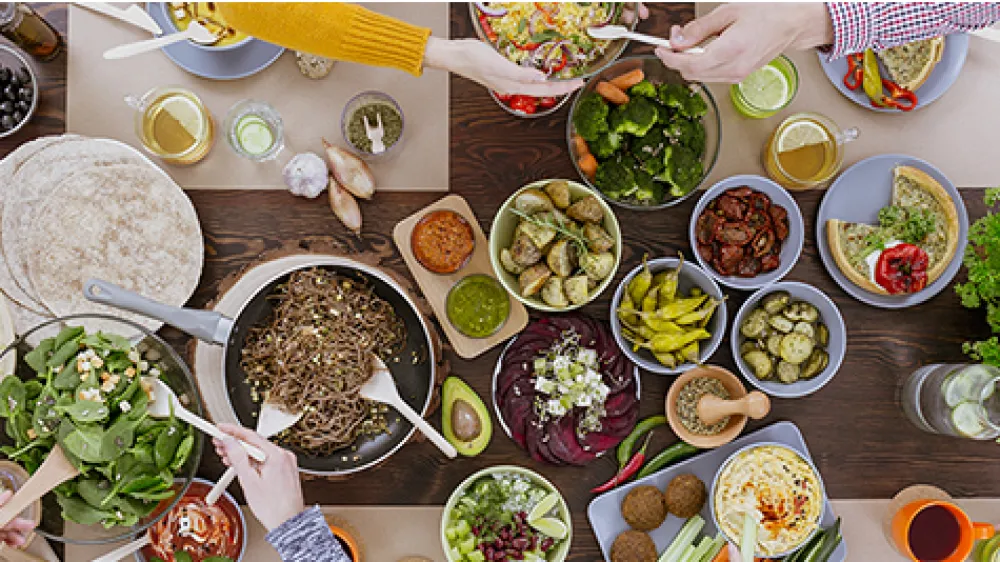Providing your location allows us to show you nearby locations and doctors.
Nourishing the Heart

02/20/2020
While heart health can be achieved in a variety of ways, including exercise, not smoking and limiting alcohol, what we choose to eat is perhaps the most important element for both physical and mental well-being. These nutritional tips may provide cardiac benefits for both men and women.
Learn more about nutrition counseling.
- Choose foods such as whole grains, fruits, vegetables, lean protein, low-fat or fat-free dairy products and heart-healthy fats.
- Limit your calories and have more high-fiber foods such as whole grains, fruits and vegetables.
- Fiber can help you lose weight and keep the pounds off by filling you up faster and for a longer time.
- Fat should make up 20 to 35 percent of your total calories, with only 10 percent coming from saturated fat. Research shows eating too much saturated fat is not good for the heart. Foods such as bacon, red meat, butter and ice cream contain saturated fat.
- You also should avoid trans fats or partially hydrogenated oils. These fats can clog arteries and raise cholesterol levels. Trans fats are found in commercial baked goods and fried foods.
- Unsaturated fat is another story. It has been found to be beneficial for overall cardiovascular health. Foods such as olive oil, canola oil, avocados, walnuts and almonds contain unsaturated fat. They help cholesterol levels by raising “good” HDL cholesterol and lowering “bad” LDL cholesterol. But even though they are good for you, they are high in calories, so limit your intake.
- Omega-3 fatty-acids, a type of unsaturated fat, have been found to be helpful in preventing sudden death from heart attacks. Fatty fish, such as salmon, mackerel, tuna and herring, contain two types of omega-3 fatty acids, docosahexaenoic acid (DHA) and eicosapentaenoic acid (EPA). The recommended intake for omega-3 fatty acids is 500 milligrams per day. That’s about two, 6-ounce servings of fatty fish per week.
- Another type of omega-3 fatty acids, alpha-linolenic acid (ALA), provides cardiac benefits. Flaxseeds and walnuts contain ALA. Eat 2 tablespoons of ground flaxseed or 1 ounce (about a handful) of walnuts each day for heart health.
- Eat less fatty meats and more plant-based foods, such as fruits and vegetables. Not only are fruits and vegetables low in calories and high in fiber and antioxidants, they can help keep blood pressure in check. High blood pressure is a major risk factor for heart attack and stroke. What makes fruits and veggies so good? They are packed with potassium, a mineral that has been shown to lower blood pressure in clinical studies.
- Aim for 4,700 milligrams of potassium every day for good blood pressure. That’s at least 2 cups of fruit and 2 1/2 cups of vegetables daily. The best picks are tomatoes, leafy greens, potatoes, bananas and squash.
- A 40-inch (or larger) waistline for men and a 35-inch (or larger) waistline for women may be dangerous for health. Losing belly fat is important. Slow weight loss offers the best results.
- Do not deny yourself everything at once. Try gradually subtracting about 500 calories from your daily intake instead. This can be done with more moderate portion sizes and limiting added sugars and fats. With this strategy, you will lose about 1 pound a week. It doesn’t take much to see results; with a 5 to 10 percent drop in weight, overall health improves.
- Exercise is the magic pill everyone is looking for. Aim for at least 30 to 60 minutes of regular, aerobic exercise most days of the week. Simple daily activities make a big difference. This includes walking, jogging, biking and dancing.
- Participate in strength training, such as weightlifting, at least two to three times per week.
Please enjoy a heart healthy recipe from Putnam Hospital Center’s Executive Chef Robert DiSalvo:
Lentil Apple Salad
Serves four
- 1 cup dry lentils, rinsed
- 1 apple, peeled and diced
- 2 tablespoons red wine vinegar
- 1 tablespoon lemon juice
- 2 tablespoons olive oil
- 1/2 teaspoon Dijon mustard
- salt and pepper
- 1/4 cup toasted walnuts
- 2 tablespoons parsley
- 6 1/2 cups vegetable stock
- 2 scallions, finely sliced
Add the vegetable stock to a large saucepan and bring to a boil. Reduce to a simmer and add the lentils. Cook for 25-30 minutes until the lentils are soft. When soft, drain excess liquid and place on a flat sheet tray and put in the refrigerator to cool.
While the lentils are cooling, mix the red wine vinegar, olive oil, lemon juice and mustard to make the dressing. Add the finely sliced scallions. Taste and season as you like. Pour the dressing into a large bowl.
Core, peel and dice the apple. Add to the bowl with the dressing and toss to coat it. This will prevent the apple from going brown.
Once the lentils are cool, add to the bowl with the apple and dressing, toss in the toasted walnuts and mix until all is coated well with the dressing.